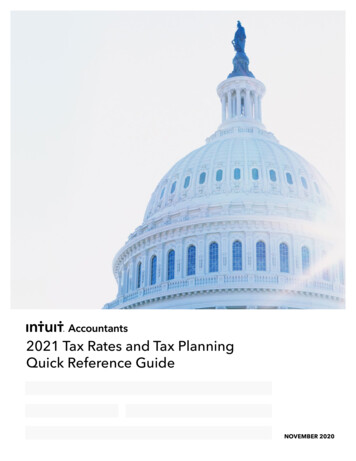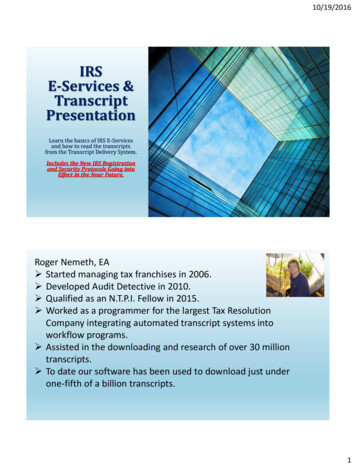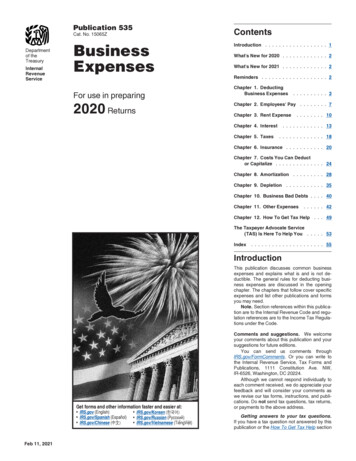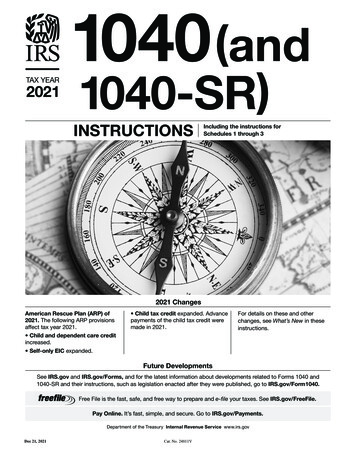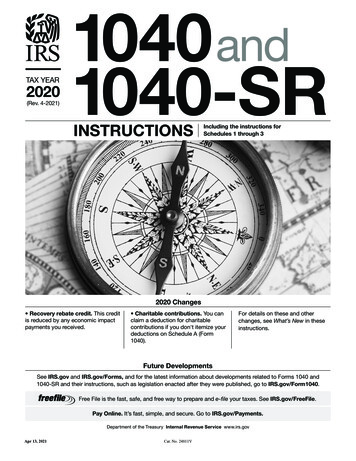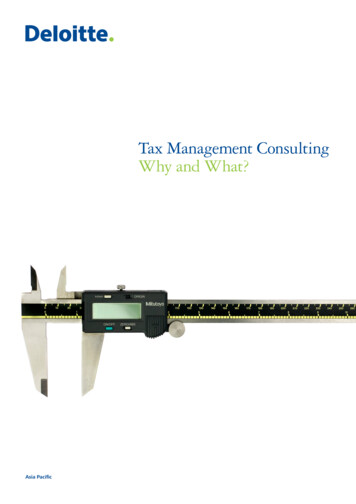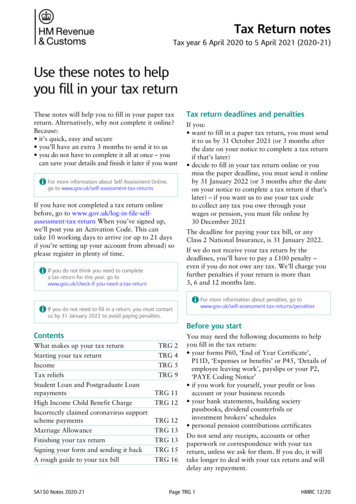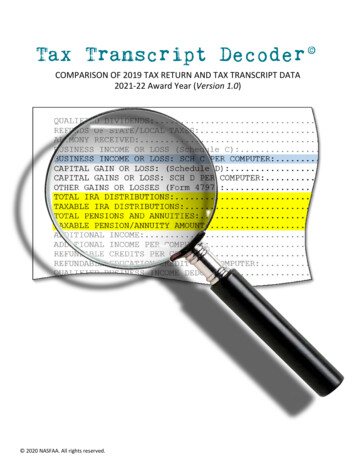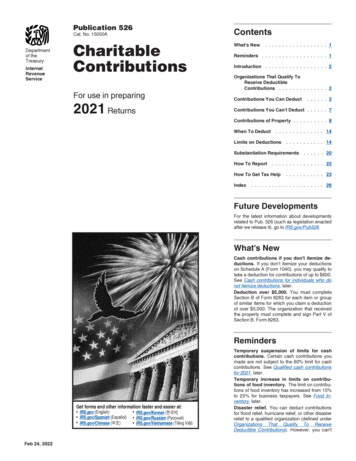
Transcription
Publication 526ContentsCharitableContributionsWhat's NewCat. No. 15050ADepartmentof theTreasuryInternalRevenueServiceFor use in preparing2021 Returns. 1Reminders . . . . . . . . . . . . . . . . . . . 1Introduction . . . . . . . . . . . . . . . . . . 2Organizations That Qualify ToReceive DeductibleContributions . . . . . . . . . . . . . . 2Contributions You Can Deduct. 3Contributions You Can't Deduct . . . . . . 7Contributions of Property . . . . . . . . . . 8When To Deduct. . . . . . . . . . . . . . 14Limits on Deductions. . . . . . . . . . . 14Substantiation RequirementsHow To Report. . . . . . . . . . . . . . . 22How To Get Tax HelpIndex. . . . . . 20. . . . . . . . . . . 23. . . . . . . . . . . . . . . . . . . . . 26Future DevelopmentsFor the latest information about developmentsrelated to Pub. 526 (such as legislation enactedafter we release it), go to IRS.gov/Pub526.What's NewCash contributions if you don’t itemize deductions. If you don’t itemize your deductionson Schedule A (Form 1040), you may qualify totake a deduction for contributions of up to 600.See Cash contributions for individuals who donot itemize deductions, later.Deduction over 5,000. You must completeSection B of Form 8283 for each item or groupof similar items for which you claim a deductionof over 5,000. The organization that receivedthe property must complete and sign Part V ofSection B, Form 8283.RemindersGet forms and other information faster and easier at: IRS.gov (English) IRS.gov/Spanish (Español) IRS.gov/Chinese (中文)Feb 24, 2022 IRS.gov/Korean (한국어) IRS.gov/Russian (Pусский) IRS.gov/Vietnamese (Tiếng Việt)Temporary suspension of limits for cashcontributions. Certain cash contributions youmade are not subject to the 60% limit for cashcontributions. See Qualified cash contributionsfor 2021, later.Temporary increase in limits on contributions of food inventory. The limit on contributions of food inventory has increased from 15%to 25% for business taxpayers. See Food Inventory, later.Disaster relief. You can deduct contributionsfor flood relief, hurricane relief, or other disasterrelief to a qualified organization (defined underOrganizations That Qualify To ReceiveDeductible Contributions). However, you can't
deduct contributions earmarked for relief of aparticular individual or family. See Pub. 976,Disaster Relief, for more information.Pub. 3833, Disaster Relief, Providing Assistance Through Charitable Organizations, hasmore information about disaster relief, includinghow to establish a new charitable organization.You can also find more information on IRS.gov.Enter “disaster relief” in the search box.Qualified disaster area. A 2020 qualified disaster area is any area in which a major disasterwas declared before February 26, 2021, by thePresident under section 401 of the Stafford Actand that occurred after December 27, 2019,and before December 28, 2020. However, aqualified disaster area doesn’t include any areadeclared a disaster only because of the Coronavirus Disease (COVID-19). See Temporarysuspension of limits, later, for additional information about 2018 and 2019 disasters.Temporary suspension of limits. Certaincash contributions you made for relief efforts for2019 and 2020 disasters are not subject to the60% limit for cash contributions. See Qualifiedcontributions for relief efforts for 2018 and 2019disasters, later.Virginia Beach Strong Act. A special rule applies to cash contributions made on or afterMay 31, 2019, and before June 1, 2021, for therelief of the families of dead or wounded victimsof the mass shooting in Virginia Beach, Virginia,on May 31, 2019. See Contributions You CanDeduct, later.Reduced deductibility of state and local taxcredits. If you make a payment or transferproperty to or for the use of a qualified organization and you receive or expect to receive a stateor local tax credit or a state or local tax deduction in return, your charitable contribution deduction may be reduced. See State or local taxcredit, later.Photographs of missing children. The IRS isa proud partner with the National Center forMissing & Exploited Children (NCMEC). Photographs of missing children selected by theCenter may appear in this publication on pagesthat would otherwise be blank. You can helpbring these children home by looking at thephotographs and calling s.com if you recognize a child.IntroductionThis publication explains how individuals claima deduction for charitable contributions. It discusses the types of organizations to which youcan make deductible charitable contributionsand the types of contributions you can deduct. Italso discusses how much you can deduct, whatrecords you must keep, and how to report charitable contributions.A charitable contribution is a donation or giftto, or for the use of, a qualified organization. It isvoluntary and is made without getting, or expecting to get, anything of equal value.Qualified organizations. Qualified organizations include nonprofit groups that are religious,charitable, educational, scientific, or literary inpurpose, or that work to prevent cruelty to children or animals. You will find descriptions ofPage 2these organizations under Organizations ThatQualify To Receive Deductible Contributions.Schedule A (Form 1040) required. Generally, to deduct a charitable contribution, youmust itemize deductions on Schedule A (Form1040). The amount of your deduction may belimited if certain rules and limits explained inthis publication apply to you.Exception: You may be eligible to deduct acash contribution even if you don’t itemize deductions on Schedule A (Form 1040). See Cashcontributions for individuals who do not itemizedeductions next.Cash contributions for individuals who donot itemize deductions. For the 2021 taxyear, cash contributions up to 600 can beclaimed on Form 1040 or 1040-SR, line 12b.Enter the total amount of your contribution online 12b. Don’t enter more than: 300 if single, head of household, or qualifying widow(er); 600 if married filing jointly; or 300 if married filing separately.In order to claim the contribution, you mustmeet the following requirements.Getting answers to your tax questions.If you have a tax question not answered by thispublication or the How To Get Tax Help sectionat the end of this publication, go to the IRS Interactive Tax Assistant page at IRS.gov/Help/ITA where you can find topics by using thesearch feature or viewing the categories listed.Getting tax forms, instructions, and publications. Go to IRS.gov/Forms to downloadcurrent and prior-year forms, instructions, andpublications.Ordering tax forms, instructions, andpublications. Go to IRS.gov/OrderForms toorder current forms, instructions, and publications; call 800-829-3676 to order prior-yearforms and instructions. The IRS will processyour order for forms and publications as soonas possible. Don’t resubmit requests you’ve already sent us. You can get forms and publications faster online.Useful ItemsYou may want to see:Publication561 Determining the Value of DonatedProperty5611. You cannot itemize deductions on Schedule A (Form 1040); and2. The charitable contribution must be:a. Paid in cash or by check.b. Be paid to an organization describedlater under First category of qualifiedorganizations (50% limit organizations) (other than certain private foundations described in section 509(a)(3)or for the establishment of a new, ormaintenance of an existing, donor advised fund, as described in section4966(d)(2)).Contributions of noncash property and contributions carried forward from prior years don’tqualify for this deduction.For records you must keep, see Substantiation Requirements, later.Note. You cannot claim the deduction onForm 1040 or 1040-SR, line 12b, and fileSchedule A (Form 1040). You may benefit fromitemizing deductions if your itemized deductions are greater than the standard deduction. Ifyou have a choice, you should generally usethe method that gives you the lower tax.Comments and suggestions. We welcomeyour comments about this publication and suggestions for future editions.You can send us comments throughIRS.gov/FormComments. Or, you can write tothe Internal Revenue Service, Tax Forms andPublications, 1111 Constitution Ave. NW,IR-6526, Washington, DC 20224.Although we can’t respond individually toeach comment received, we do appreciate yourfeedback and will consider your comments andsuggestions as we revise our tax forms, instructions, and publications. Don’t send tax questions, tax returns, or payments to the above address.976 Disaster Relief976Forms (and Instructions)Schedule A (Form 1040) ItemizedDeductionsSchedule A (Form 1040)8283 Noncash Charitable Contributions8283See How To Get Tax Help near the end of thispublication for information about getting thesepublications and forms.Organizations ThatQualify To ReceiveDeductibleContributionsYou can deduct your contributions only if youmake them to a qualified organization.How to check whether an organization canreceive deductible charitable contributions.You can ask any organization whether it is aqualified organization, and most will be able totell you. You can also check by going toIRS.gov/TEOS. This online tool will enable youto search for qualified organizations.Types of QualifiedOrganizationsGenerally, only the following types of organizations can be qualified organizations.1. A community chest, corporation, trust,fund, or foundation organized or created inor under the laws of the United States, anystate, the District of Columbia, or any possession of the United States (including Puerto Rico). It must, however, be organizedand operated only for charitable, religious,Publication 526 (2021)
scientific, literary, or educational purposes, or for the prevention of cruelty to children or animals. Certain organizations thatfoster national or international amateursports competition also qualify.2. War veterans' organizations, includingposts, auxiliaries, trusts, or foundations organized in the United States or any of itspossessions (including Puerto Rico).3. Domestic fraternal societies, orders, andassociations operating under the lodgesystem. (Your contribution to this type oforganization is deductible only if it is to beused solely for charitable, religious, scientific, literary, or educational purposes, orfor the prevention of cruelty to children oranimals.)4. Certain nonprofit cemetery companies orcorporations. (Your contribution to thistype of organization isn't deductible if itcan be used for the care of a specific lot ormausoleum crypt.)5. The United States or any state, the Districtof Columbia, a U.S. possession (includingPuerto Rico), a political subdivision of astate or U.S. possession, or an Indiantribal government or any of its subdivisionsthat perform substantial government functions. (Your contribution to this type of organization is deductible only if it is to beused solely for public purposes.)Example 1. You contribute cash toyour city's police department to be usedas a reward for information about a crime.The city police department is a qualifiedorganization, and your contribution is for apublic purpose. You can deduct your contribution.Example 2. You make a voluntarycontribution to the social security trustfund, not earmarked for a specific account. Because the trust fund is part of theU.S. Government, you contributed to aqualified organization. You can deductyour contribution.Examples. The following list gives some examples of qualified organizations. Churches, a convention or association ofchurches, temples, synagogues, mosques,and other religious organizations. Most nonprofit charitable organizationssuch as the American Red Cross and theUnited Way. Most nonprofit educational organizations,including the Boy Scouts of America, GirlScouts of America, colleges, and museums. This also includes nonprofit daycarecenters that provide childcare to the general public if substantially all the childcareis provided to enable parents and guardians to be gainfully employed. However, ifyour contribution is a substitute for tuitionor other enrollment fee, it isn't deductibleas a charitable contribution, as explainedlater under Contributions You Can't Deduct. Nonprofit hospitals and medical researchorganizations. Utility company emergency energy programs, if the utility company is an agent forPublication 526 (2021)Table 1. Examples of Charitable Contributions—A Quick CheckUse the following lists for a quick check of whether you can deduct acontribution. See the rest of this publication for more information andadditional rules and limits that may apply.Deductible AsCharitable ContributionsMoney or property you give to: Churches, synagogues, temples,mosques, and other religiousorganizations Federal, state, and localgovernments, if your contribution issolely for public purposes (forexample, a gift to reduce the publicdebt or maintain a public park) Nonprofit schools and hospitals The Salvation Army, American Red Cross, CARE,Goodwill Industries, United Way, Boy Scouts ofAmerica, Girl Scouts of America, Boys and GirlsClubs of America, etc. War veterans' groupsNot Deductible AsCharitable ContributionsMoney or property you give to: Civic leagues, social and sportsclubs, labor unions, and chambers ofcommerce Foreign organizations (except certainCanadian, Israeli, and Mexicancharities) Groups that are run for personalprofit Groups whose purpose is to lobby forlaw changes Homeowners' associations Individuals Political groups or candidates forpublic officeExpenses paid for a student living with you, sponsored by a Cost of raffle, bingo, or lottery ticketsqualified organizationDues, fees, or bills paid to country clubs, lodges, fraternalOut-of-pocket expenses when you serve a qualifiedorders, or similar groupsorganization as a volunteerTuitionValue of your time or servicesValue of blood given to a blood banka charitable organization that assists individuals with emergency energy needs. Nonprofit volunteer fire companies. Nonprofit organizations that develop andmaintain public parks and recreation facilities. Civil defense organizations.limited to 25% of your adjusted gross incomefrom Israeli sources.Canadian charities. You may be able to deduct contributions to certain Canadian charitable organizations covered under an income taxtreaty with Canada. To deduct your contributionto a Canadian charity, you must generally haveincome from sources in Canada. See Pub. 597,Information on the United States–Canada Income Tax Treaty, for information on how to figure your deduction.Generally, you can deduct contributions ofmoney or property you make to, or for the useof, a qualified organization. A contribution is “forthe use of” a qualified organization when it isheld in a legally enforceable trust for the qualified organization or in a similar legal arrangement.Mexican charities. Under the U.S.–Mexico income tax treaty, a contribution to a Mexicancharitable organization may be deductible, butonly if and to the extent the contribution wouldhave been treated as a charitable contributionto a public charity created or organized underU.S. law. To deduct your contribution to a Mexican charity, you must have income from sources in Mexico. The limits described in Limits onDeductions, later, apply and are figured usingyour income from Mexican sources.Israeli charities. Under the U.S.–Israel income tax treaty, a contribution to an Israelicharitable organization is deductible if and tothe extent the contribution would have beentreated as a charitable contribution if the organization had been created or organized underU.S. law. To deduct your contribution to an Israeli charity, you must have income from sourcesin Israel. The limits described in Limits on Deductions, later, apply. The deduction is alsoContributionsYou Can DeductThe contributions must be made to a qualified organization and not set aside for use by aspecific person.Virginia Beach Strong Act. If you made acontribution for the relief of the families of thedead or wounded victims of the mass shootingin Virginia Beach, Virginia, on May 31, 2019,you may be able to deduct that contribution. Inorder to deduct the contribution, it must havebeen made: In cash or check; Between May 31, 2019, and June 1, 2021;and For the relief of the families of dead orwounded victims of the mass shooting inVirginia Beach, Virginia, on May 31, 2019.If you made your contribution byTIP phone, keep your phone bill showingthe name of who you made the donation to, the date you made the contribution, andthe amount of the contribution. See Substantiation Requirements, later.If you give property to a qualified organization, you can generally deduct the fair marketPage 3
value (FMV) of the property at the time of thecontribution. See Contributions of Property,later.Your deduction for charitable contributionsgenerally can't be more than 60% of your adjusted gross income (AGI), but in some cases20%, 30%, or 50% limits may apply.The 60% limit is suspended for certainTIP cash contributions. See Qualified cashcontributions for 2021 and Qualifiedcontributions for relief efforts for 2018 and 2019disasters, later.Table 1 gives examples of contributions youcan and can't deduct.Contributions FromWhich You BenefitIf you receive a benefit as a result of making acontribution to a qualified organization, you candeduct only the amount of your contribution thatis more than the value of the benefit you receive. Also see Contributions From Which YouBenefit under Contributions You Can't Deduct,later.If you pay more than fair market value to aqualified organization for goods or services, theexcess may be a charitable contribution. Forthe excess amount to qualify, you must pay itwith the intent to make a charitable contribution.Example 1. You pay 65 for a ticket to adinner dance at a church. Your entire 65 payment goes to the church. The ticket to the dinner dance has a fair market value of 25. Whenyou buy your ticket, you know its value is lessthan your payment. To figure the amount ofyour charitable contribution, subtract the valueof the benefit you receive ( 25) from your totalpayment ( 65). You can deduct 40 as a charitable contribution to the church.Example 2. At a fundraising auction conducted by a charity, you pay 600 for a week'sstay at a beach house. The amount you pay isno more than the fair rental value. You haven'tmade a deductible charitable contribution.Charity benefit events. If you pay a qualifiedorganization more than fair market value for theright to attend a charity ball, banquet, show,sporting event, or other benefit event, you candeduct only the amount that is more than thevalue of the privileges or other benefits you receive.If there is an established charge for theevent, that charge is the value of your benefit. Ifthere is no established charge, the reasonablevalue of the right to attend the event is the valueof your benefit. Whether you use the tickets orother privileges has no effect on the amountyou can deduct. However, if you return theticket to the qualified organization for resale,you can deduct the entire amount you paid forthe ticket.Page 4Even if the ticket or other evidence ofpayment indicates that the payment isCAUTION a “contribution,” this doesn't mean youcan deduct the entire amount. If the ticketshows the price of admission and the amount ofthe contribution, you can deduct the contribution amount.!Example. You pay 40 to see a specialshowing of a movie for the benefit of a qualifiedorganization. Printed on the ticket is “Contribution— 40.” If the regular price for the movie is 8, your contribution is 32 ( 40 payment 8regular price).State or local tax credit. If you make a payment or transfer property to or for the use of aqualified organization and receive or expect toreceive a state or local tax credit in return, thenthe amount treated as a charitable contributiondeduction is reduced by the amount of the stateor local tax credit you receive or expect to receive in consideration for your payment ortransfer, but an exception may apply. If an exception doesn’t apply, you must reduce yourcharitable contribution deduction even if youcan’t claim the state tax credit in the year.Exception. If the state or local tax credityou receive or expect to receive doesn’t exceed15% of your payment amount or 15% of the fairmarket value of the transferred property, thenyour charitable contribution deduction isn’t reduced.Example 1. You make a cash contributionof 1,000 to charity X, a qualified organization.In return for your payment you receive or expectto receive a state tax credit of 70% of your 1,000 contribution. The amount of your charitable contribution to charity X is reduced by 700 (70% of 1,000). The result is your charitable contribution deduction to charity X can’texceed 300 ( 1,000 donation - 700 state taxcredit). The reduction applies even if you can’tclaim the state tax credit for that year. Your deductible charitable contribution to charity X is 300. Your total contributions may still be subject to limitations. See Limits on Deductions,later.Example 2. You donate a painting to charity Y, a qualified organization. At the time of thedonation, the painting has a fair market value of 100,000. In return for the painting, you receiveor expect to receive a state tax credit of 10% ofthe fair market value of the painting. The statetax credit is 10,000 (10% of 100,000). Theamount of your state tax credit does not exceed15% of the fair market value of the painting. Asa result, your charitable contribution deductionto charity Y is not reduced. Your deductiblecharitable contribution for your noncash contribution to charity Y is 100,000. However, yourtotal contributions may still be subject to limitations. See Limits on Deductions, later.State or local tax deduction. If you make apayment or transfer property to a qualified organization and receive or expect to receive astate or local tax deduction in return, then theamount of your charitable contribution deduction to the organization may be reduced insome circumstances. If the amount of the stateor local tax deduction exceeds the amount ofyour cash contribution or the fair market valueof the transferred property, then your charitablecontribution deduction is reduced. However, ifthe amount of the state or local tax deductiondoesn’t exceed the amount of your payment orthe fair market value of the transferred property,then no reduction is necessary.Example 1. You make a cash contributionof 1,000 to charity Z, a qualified organization.Under state law, you are entitled to receive astate tax deduction of 1,000 in return for yourpayment. The amount of your charitable contribution deduction to charity Z isn’t reduced. Yourcharitable contribution deduction to charity Z is 1,000. However, your total contributions maystill be subject to limitations. See Limits on Deductions, later.Membership fees or dues. You may be ableto deduct membership fees or dues you pay toa qualified organization. However, you can deduct only the amount that is more than the valueof the benefits you receive.You can't deduct dues, fees, or assessments paid to country clubs and other social organizations. They aren't qualified organizations.Certain membership benefits can be disregarded. Both you and the organization candisregard the following membership benefits ifyou get them in return for an annual payment of 75 or less.1. Any rights or privileges that you can usefrequently while you are a member, suchas:a. Free or discounted admission to theorganization's facilities or events,b. Free or discounted parking,c. Preferred access to goods or services, andd. Discounts on the purchase of goodsand services.But, item (1) doesn’t include rights topurchase tickets for seating at an athleticevent in an athletic stadium of a college oruniversity as a result of a contribution tosuch institution.2. Admission, while you are a member, toevents open only to members of the organization if the organization reasonablyprojects that the cost per person (excluding any allocated overhead) isn't morethan 11.30.Token items. You don't have to reduce yourcontribution by the value of any benefit you receive if both of the following are true.1. You receive only a small item or other benefit of token value.2. The qualified organization correctly determines that the value of the item or benefityou received isn't substantial and informsyou that you can deduct your payment infull.Publication 526 (2021)
Table 2. Volunteers' Questions and AnswersIf you volunteer for a qualified organization, the following questions and answers may apply to you. All of therules explained in this publication also apply. See, in particular, Out-of-Pocket Expenses in Giving Services.QuestionAnswerI volunteer 6 hours a week in the office of a qualified organization. The receptionist is paid 10 an hour for the same work. Can I deduct 60 a week for my time?No, you can't deduct the value of your time or services.The office is 30 miles from my home. Can I deduct any of my car expenses for these trips?Yes, you can deduct the costs of gas and oil that are directly related togetting to and from the place where you volunteer. If you don'twant to figure your actual costs, you can deduct 14 cents for eachmile.I volunteer as a Red Cross nurse's aide at a hospital. Can I deduct the cost of the uniforms Imust wear?Yes, you can deduct the cost of buying and cleaning your uniforms ifthe hospital is a qualified organization, the uniforms aren't suitable foreveryday use, and you must wear them when volunteering.I pay a babysitter to watch my children while I volunteer for a qualified organization. Can Ideduct these costs?No, you can't deduct payments for childcare expenses as acharitable contribution, even if you would be unable to volunteer without childcare. (If youhave childcare expenses so you can work for pay, see Pub. 503, Child and DependentCare Expenses.)The organization determines whether the valueof an item or benefit is substantial by using Revenue Procedures 90-12 and 92–49 and the inflation adjustment in Revenue Procedure2020-45.Written statement. A qualified organizationmust give you a written statement if you make apayment of more than 75 that is partly a contribution and partly for goods or services. Thestatement must say you can deduct only theamount of your payment that is more than thevalue of the goods or services you received. Itmust also give you a good faith estimate of thevalue of those goods or services.The organization can give you the statementeither when it solicits or when it receives thepayment from you.Exception. An organization won't have togive you this statement if one of the following istrue.1. The organization is:a. A governmental organization described in (5) under Types of QualifiedOrganizations, earlier, orb. An organization formed only for religious purposes, and the only benefityou receive is an intangible religiousbenefit (such as admission to a religious ceremony) that generally isn'tsold in commercial transactions outside the donative context.2. You receive only items whose value isn'tsubstantial, as described under Tokenitems, earlier.3. You receive only membership benefits thatcan be disregarded, as described underMembership fees or dues, earlier.Expenses Paid forStudent Living With YouYou may be able to deduct some expenses ofhaving a student live with you. You can deductqualifying expenses for a foreign or Americanstudent who:1. Lives in your home under a written agreement between you and a qualified organization (defined later) as part of a programPublication 526 (2021)of the organization to provide educationalopportunities for the student,2. Isn't your relative (defined later) or dependent (also defined later), and3. Is a full-time student in the twelfth or anylower grade at a school in the UnitedStates.You can deduct up to 50 a month forTIP each full calendar month the studentlives with you. Any month when conditions (1) through (3) are met for 15 or more dayscounts as a full month.Qualified organization. For these purposes, aqualified organization can be any of the organizations described earlier under Types of Qualified Organizations, except those in (4) and (5).For example, if you are providing a home for astudent as part of a state or local governmentprogram, you can't deduct your expenses ascharitable contributions. But see Foster parentsunder Out-of-Pocket Expenses in Giving Services, later, if you provide the home as a fosterparent.Relative. The term “relative” means any of thefollowing persons. Your child, stepchild, foster child, or a descendant of any of them (for example, yourgrandchild). A legally adopted child is considered your child. Your brother, sister, half brother, half sister, stepbrother, or stepsister. Your father, mother, grandparent, or otherdirect ancestor. Your stepfather or stepmother. A son or daughter of your brother or sister. A brother or sister of your father or mother. Your son-in-law, daughter-in-law, father-in-law, mother-in-law, brother-in-law,or sister-in-law.Dependent. For this purpose, the term “dependent” means:1. A person you can claim as a dependent,or2. A person you could have claimed as a dependent except that:a. He or she received gross income of 4,300 or more;b. He or she filed a joint return; orc. You, or your spouse if filing jointly,could be claimed as a dependent onsomeone else's 2021 return.Foreign students brought to this coun-TIP try under a qualified international edu-cation exchange program and placedin American homes for a temporary period generally aren't U.S. residents and can't be claimedas dependents.Qualifying expenses. You may be able to deduct the cost of books, tuition, food, clothing,transportation, medical and dental care, entertainment, and other amounts you actuallyspend for the well-being of the student.Expenses that don't qualify. You
purpose, or that work to prevent cruelty to chil-dren or animals. You will find descriptions of these organizations under Organizations That Qualify To Receive Deductible Contributions. Schedule A (Form 1040) required. Gener-ally, to deduct a charitable contribution, you must itemize deductions on Schedule A (Form 1040).

